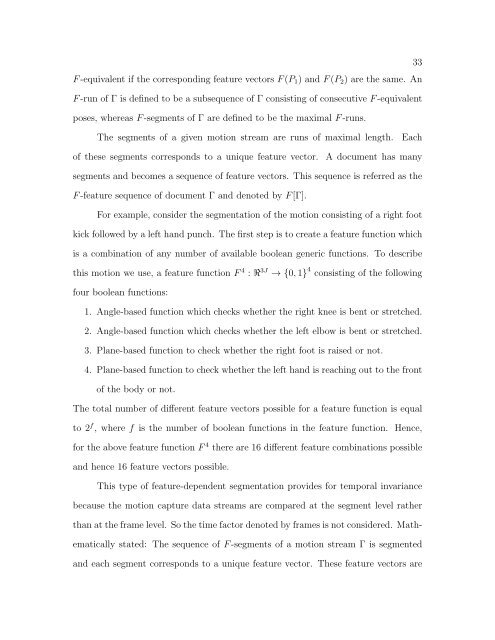A COMPARISON AND EVALUATION OF MOTION INDEXING ...
A COMPARISON AND EVALUATION OF MOTION INDEXING ...
A COMPARISON AND EVALUATION OF MOTION INDEXING ...
You also want an ePaper? Increase the reach of your titles
YUMPU automatically turns print PDFs into web optimized ePapers that Google loves.
F -equivalent if the corresponding feature vectors F (P1) and F (P2) are the same. An<br />
F -run of Γ is defined to be a subsequence of Γ consisting of consecutive F -equivalent<br />
poses, whereas F -segments of Γ are defined to be the maximal F -runs.<br />
The segments of a given motion stream are runs of maximal length. Each<br />
of these segments corresponds to a unique feature vector. A document has many<br />
segments and becomes a sequence of feature vectors. This sequence is referred as the<br />
F -feature sequence of document Γ and denoted by F [Γ].<br />
For example, consider the segmentation of the motion consisting of a right foot<br />
kick followed by a left hand punch. The first step is to create a feature function which<br />
is a combination of any number of available boolean generic functions. To describe<br />
this motion we use, a feature function F 4 : ℜ 3J → {0, 1} 4 consisting of the following<br />
four boolean functions:<br />
1. Angle-based function which checks whether the right knee is bent or stretched.<br />
2. Angle-based function which checks whether the left elbow is bent or stretched.<br />
3. Plane-based function to check whether the right foot is raised or not.<br />
4. Plane-based function to check whether the left hand is reaching out to the front<br />
of the body or not.<br />
The total number of different feature vectors possible for a feature function is equal<br />
to 2 f , where f is the number of boolean functions in the feature function. Hence,<br />
for the above feature function F 4 there are 16 different feature combinations possible<br />
and hence 16 feature vectors possible.<br />
This type of feature-dependent segmentation provides for temporal invariance<br />
because the motion capture data streams are compared at the segment level rather<br />
than at the frame level. So the time factor denoted by frames is not considered. Math-<br />
ematically stated: The sequence of F -segments of a motion stream Γ is segmented<br />
and each segment corresponds to a unique feature vector. These feature vectors are<br />
33
















